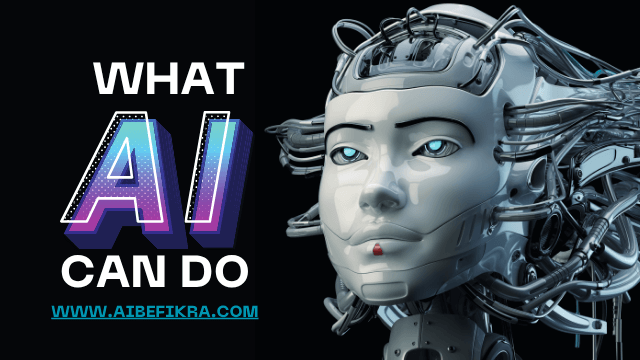What is AI? A Start Guide for Artificial Intelligence (2025)
In today’s digital age, artificial intelligence (AI) is everywhere—from smart speakers to self-driving cars. But what exactly is AI? Are there just robots and talking machines, or is it already part of your daily life?
In this guide we want to find out what AI is, how it works, its real use, type, profit, and risk, and in 2025—all single, in human language.
What is AI :- (artificial intelligence)?
Artificial intelligence( AI) refers to the reproduction of mortal intelligence in machines that are programmed to suppose, learn, and decide as mortal beings.
AI activates the system.
Understand the voice command (e.g., Alexa, Siri).
Identify photos and faces (e.g., in a smartphone or CCTV).
Recommends videos or products (e.g., Netflix, Amazon)
Translation language (e.g., Google Translate)
Drive cars (e.g., Tesla).
💡 Simply put, AI data is a machine’s capacity to perform “smart” work using logic and algorithms.
How does AI work?
AI systems learn patterns from large datasets and make predictions or decisions based on these patterns. It combines many technologies:
Machine Learning (ML)—Teaches machines to learn from data.
Natural Language Processing (NLP) lets machines understand human language (used in chat).
Computer vision—AEI allows AI to “watch” and analyze photos or videos.
Example: When talking to Google Assistant, it uses NLP to understand your request and ML to improve your answer over time.
What is AI? Type of AI
There are three main types of AI, with each having different options. :
1. Small AI (weak AI)
Specializes in a task.
Today it is the most common type.
Example: Google Maps, ChatGPT, Spotify suggestions.
2. General AI (strong AI)
All tasks have intelligence information at the human level.
Still doing research.
People can think and cause causes that humans.
3. Superintendent Ai
Hypothetical AI that crosses human intelligence.
Can solve complex problems beyond human abilities.
Faces moral and security challenges
AI’s Real-Life Application
Popular AI Career Paths:
AI Engineer
Machine Learning Developer
Data Scientist
AI Researcher
Prompt Engineer
NLP Specialist
Free Tools to Start Learning AI:
Google AI
Coursera (AI for Everyone by Andrew Ng)
YouTube tutorials
ChatGPT (learn by asking!)
What is AI? Real-life uses of AI:
AI advantages and disadvantages:
AI for beginners:
AI future scope:
AI career guide:
What is AI? 🏥 Health Services
Diagnosing diseases with scanning.
Virtual help for patients.
Drug detection and robotic surgery.
🛒 e-commerce
Personal product suggestions.
Automatic customer service (chatbots).
Inventory and Price Management.
💸 Funding
fraud detection.
Algorithm trade.
Evaluation of credit risk.
🧑 🧑 Education
Personal learning paths.
AI supervisor and exam grading.
Voice-to-text and translation tools.
🚗 Transport
Self-driving vehicles.
Traffic exception and navigation.
Route optimization for delivery.
🎮 entertainment
Netflix and YouTube recommendations.
AI-generated music and video.
Wise NPC in play.
📈 Future of AI (2025 and beyond)
AI is not just a tool—it is the future of business, education, health care, location, and daily life.
🔮 Emerging AI trends:
AI in agriculture: Predict crop yields and automate watering.
AI in education: Personal supervisor and smart assessment.
AI in room exploration: Data analysis and navigation are used by NASA and Isro.
The benefits of AI
Speed and Efficiency: Treating quick data than humans.
Cost-effective: Long-term operation reduces costs.
Accuracy: Reduces human errors in important tasks.
Privatization: Uses teacher behavior to provide analog experience.📈 Future of AI (2025 and beyond)
AI is not just a tool—it is the future of business, education, health care, location, and daily life.
🔮 Emerging AI trends:
Generic AI: Tools such as ChatGPT and Midjourney make upgrades, codes, art, and even videos.
AI in agriculture: Predict crop yields and automate watering.
AI in education: Personal supervisor and smart assessment.
AI in room exploration: Data analysis and navigation are used by NASA and Isro.
🧠 Fun Fact: By 2030, AI is expected to contribute more than $ 15 trillion to the global economy (PWC report).
The benefits of AI
Speed and Efficiency: Treating quick data than humans.
24/7 Availability: AI does not require sleep or breaks.
Cost-effective: Long-term operation reduces costs.
Accuracy: Reduces human errors in important tasks.
Privatization: Uses teacher behavior to provide analog experience.
⚠ AI Disadvantages and Risk of Job Discharge:
Automation can change repetitive jobs.
PRIESTS WITH PERSONAL PRODUCTS: Data collection improves moral concerns.
Safety hazard: Deepfake and AI hacking tools.
Upper: People can rely too much on AI, reducing important thinking.
👨 👨 This is why moral AI development is important for a safe future.
🧑 Should you learn AI in 2025?
Absolutely! AI is a top career skill. Today it is teaching you that it is preparing for yesterday’s high-paying technical jobs.
Popular AI Job Roles: AI Engineer, Machine Learning Developer Early engineer Computer scientist, NLP specialist, AI researcher
Best free resources: Google AI and Learnable Machine Coursera (AI for All—Andrew Ng) YouTube: Tim, technology with basic code ChatGPT: Ask questions, exercise signal
🙋 Frequently asked questions (FAQ)
1. What is the full form of AI?
Ans: AI means artificial intelligence, the imitation of human intelligence by machines.❓
2. Is AI used in real life?
AI is used in smartphones, health care, finance, education, e-commerce and self-driving cars. ❓
3. Can you instead of humans?
AI can automate features but can not change mortal creativity, feelings, or morality fully.
4 Is this AI safe?
AI is safe when developed and used responsibly. Moral AI development is important.❓
5. I’m starting to learn AI.
Start with a free course on the course, use AI tools like ChatGPT, and follow YouTube training programs.



[…] GPT-4 helps dozens of languages, making it beneficial for customers global. […]